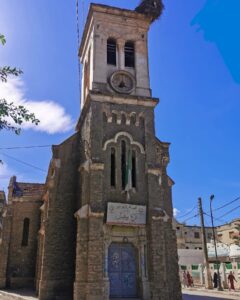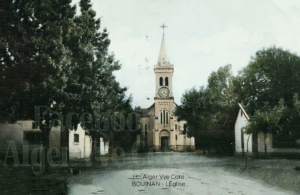Bouinan Church: From Colonial Landmark to Community Center


Bouinan Church: Architecture, History and Transformation
Origins and Colonial Foundations
The church of Bouinan sits in the heart of what was once the colonial centre of Bouinan, in Blida province. Bouinan was formally established as an administrative centre in 1886 during the French colonial era. (University of Blida)
The design of the town reflects colonial planning: a nearly square layout of about 400 meters per side (≈16 hectares) with straight, orthogonal streets, red-roofed single-story houses (some two-storey), gardens behind houses, and public structures aligned in symmetry.
Architectural Details and Urban Role
- The church is located in the southern part of the colonial centre and is oriented toward the south.
- It features a bell tower (clocher) which dominates the skyline. It functioned as a visual symbol of Christianity for the European settlers in the area.
- Around the church were other colonial public and symbolic infrastructures: a European cemetery, a music kiosk, houses laid out around the centre, and open countryside structured with order.
The church was, in effect, one of the anchors of colonial society in Bouinan — religious centre, landmark, and part of the planned ensemble of civic, religious and residential functions.
Historical Timeline
- 1886: Bouinan becomes an administrative centre under civilian colonial administration, replacing military rule in this role.
- During the colonial period, the church held its role in religious services for the European population and served as a visible mark of colonial presence.
- Throughout that era, town life and layout were deeply shaped by the positioning of the church: as a central feature (southern edge of the settlement) and as a focal point around which roads, housing, and public spaces were organized.
Transformation: From Church to Social Edifice
At some point after the colonial period, the church ceased functioning in its original religious capacity and underwent transformation. Today, the building is used by the Kafil El Yatim Association, which provides social services, especially for orphans.
This transformation reflects broader changes in Bouinan: shifts in demographics, change in governance, urbanization, and re-use of colonial infrastructure for current civic and social needs. The exact date of this conversion isn’t widely published, but it is part of Bouinan’s post-colonial evolution.